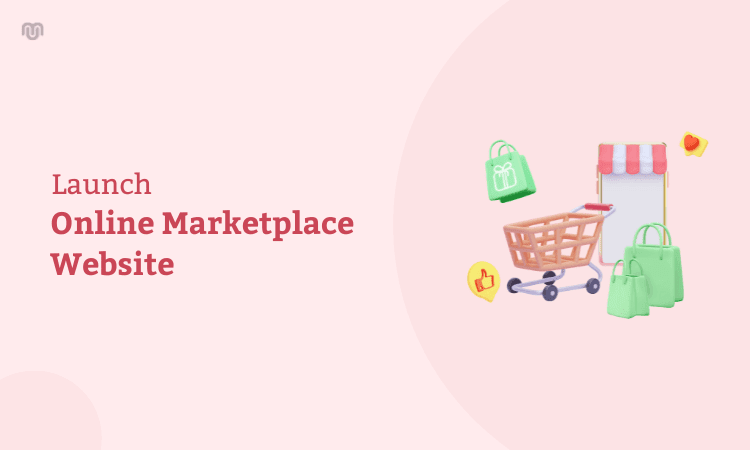Online marketplaces have been the talk of the town for a while now. With these sites getting popular day by day, more entrepreneurs are drawn toward these business models every day. E-commerce amounts to approximately 47% of global sales, according to the statistics for 2019.
Although building a marketplace can be rewarding, this e-commerce comes with its own set of challenges. However, if you’re one with an interest in the field of online commerce, you’ve come to the right place.
Read on to understand better what exactly is an online marketplace, its functions, and how to master the art of selling on the internet.
Online Marketplace: A Better Analysis
In simple words, an e-commerce site where different merchants sell goods or services to clients is known as an online marketplace. Examples of such sites include Amazon, Etsy, eBay, Shopify, etc.
There are other eCommerce website creation platforms that make the whole process much easier and simple.
Traditional e-commerce involves the selling of products from a single brand. However, online marketplaces do not restrict business to one brand. As these sites have hundreds or even thousands of sellers, the range of products they offer is enormous. This is another reason that draws more and more users to shop from online marketplaces.
One of the main advantages is that these sites bring in a lot of foot traffic, which is one of the greatest exposures to the market. Moreover, customers on an online marketplace can shop from multiple sources without having to click away to different sites.
Even if the sellers are, in no way, associated, the customer can complete the transaction on the same site. The customer also doesn’t have to pay for different items in separate transactions; they can pay all at once.
The merchants get notified when a customer buys their products, and each seller can proceed to ship their products individually. This is exactly why online marketplaces are also commonly referred to as the collaborative economy or sharing economy.
Write a Business Plan
You are too excited to jump in right away and want to launch your marketplace as soon as possible without writing a formal business plan. Please don’t make that mistake.
Thousands of eCommerce marketplaces come and go and shut down their operations within the first or second year. The most common mistake entrepreneurs make is, they do not write a business plan before getting started.
Businesses without a solid business plan are at higher risk of failure.
Investors often rely on the business plan to evaluate the business feasibility before funding it. If you want to get funding for your new marketplace or expand your existing marketplace operations, you must have a business plan.
Before you start writing your business plan, check out our complete guide on how to write a business plan and learn what details you should include in your solid business plan.
Check out our sample business plans for online and retail stores. You can use these sample business plans and can get started with your eCommerce business plan in no time with Upmetrics.
What Is the Need for Starting an Online Marketplace?
Your reason for launching an e-commerce site can be driven by either of the two factors. You can either want to help merchants sell goods or help customers get easier access to goods and services.
By launching an online marketplace, you’re helping users with a platform where they can buy, sell, or even rent goods. These platforms generally provide better quality products at a lower price and more conveniently than offline shopping.
Moreover, unlike offline markets, here, you don’t have to own any inventory. Entrepreneurs of the current age find this option attractive as the investment is very less. Online marketplaces source the inventory from the merchants who are selling them. Thus, the founder is reducing the distance between buyers and sellers with technology.
Different Categories and Online Marketplace
Although most online marketplaces work similarly, there are a few characteristic differences that affect the shopping experience. Moreover, the types of products, customer base, and services provided also vary.
The different categories of online marketplaces are:
-
Physical product online marketplace:
These markets involve merchants that create and supply physical products for their customers. The products are shipped to the customers.
-
Digital product online marketplace:
These markets sell digital products similar to their name. The users have to download products from servers. They receive their products immediately on their computers or smartphones.
-
Property and spaces online marketplace:
This place sells property, rooms, or event spaces and locations.
-
Services online marketplace:
These places sell their customer’s digital services. For instance, website development services.
Things to Consider When Creating a Marketplace Website
- 1. Understanding the target market: If you don’t understand your customers’ needs, you will never know how to convince them. Any business should have a proper idea of its target audience. Researching will help you understand the market clearly, plus finding the right solution for the consumers.
- 2. Assess the market size and volume: Form the business model only after evaluating the market by its size and volume. If you understand the market niche correctly, it is relatively easy to choose the most appropriate one to grow. However, before you jump into any marketplace, it is crucial to research the competition level and its competitors. Learning about the competitors will help you understand their strengths and weaknesses, plus what you need to grow your business in the online marketplace.
- 3. Follow User Behaviour: It is difficult to formulate a strategy without understanding the behavior of your users. Try to find out the goals and challenges of your users and precisely what motivates or influences them. The online marketplace is a two-sided marketplace, and you need to know about all the aspects of buyers and sellers.
- 4. Dig into the needs and solutions of target users: Try finding your target audience’s most significant pain points and how they reduce them. Suppose your target audience uses an online platform for shopping, know-how, where, and why. Once you know all the answers, dig deeper to find out what can be added to improve their experience. The buyers will change their platforms only when they notice something better on the other side. Know about what satisfies them and what they are unhappy about, and try strategizing around that idea.
- 5. Choose the right business model: Selecting the right model is necessary to make the right profit. After taking care of the user needs, try concentrating on designing a viable business model. On the grounds that the sellers are clear about your vision, you can initially charge them a signup fee before thriving. Subscription-based businesses are prevalent, and it also allows recurring revenues. Nothing is better than a selling fee from sellers, as the more orders they receive, the more income goes up.
- 6. Organizing the marketplace operations: Whether you operate an e-commerce platform or a wholesale B2B marketplace, the two-sided functions make the online platform a more complex thing to handle. Sellers are necessary to keep the online platform working. So, you need to focus on attracting new sellers and retaining the existing ones satisfied. There is a need for a proper process to manage the products and services sold by sellers. Check the payment processes keeping in mind the specialized marketplace payment gateways plus different kinds of payments.
- 7. Website Security: Find the right SSL certificate for data security on your website. It not only encrypts the data that can only be deciphered by the intended person but also ensures users that they are dealing with a secured website. It is necessary nowadays to purchase an SSL certificate and install SSL on the server.
- 8. Grow the business through content management: In the long run, growing your business by focusing on the content to attract more consumers is a necessary step. Learn about SEO, business development initiatives, and paid marketing campaigns.
Challenges You Might Come Across at the Beginning
Like all other businesses, online marketplaces have challenges that you’re bound to come across in the beginning. Although these challenges aren’t mainstream, you should remember that your business, too, isn’t widespread.
However, don’t let these challenges dampen your spirits. Here’s a list of the most common challenges faced in the initial phases of launching an online marketplace.
- Convincing buyers and sellers to use your website can be challenging until you establish your reputation.
- You need to dedicate a good chunk of your time to developing a successful marketplace.
- You must provide useful services to your customers.
- You have to face the existing market competition.
- You might also face trouble in financing your marketplace.
You must be aware of these challenges so that you can be prepared to ace your business when the time comes.
Factors to Keep in Mind While Launching an E-commerce Platform to Make It Successful
Before you publish your site, ensure that it fulfills the following requirements.
- Users should be able to log in with their favorite social media accounts.
- Acquire personal information on the profile page.
- Verification procedure, especially for the sellers.
- Customers should be able to edit, add or remove products from the list.
- A detailed description of the products.
- Searches and filters are necessary for a good experience for the customer.
- Notifications to alert users about new offers and updates in their orders.
- Functional payment process.
- Wishlist.
- History of the purchases.
Getting Your Online Marketplace Website on the Internet
Once you’ve ticked all the checkboxes, it’s time for you to get started. The following are the main steps to follow while launching your platform.
- 1. Finding a domain: Make sure that your site has a simple, unique, and memorable name. You can also register more than one domain to increase your number of options.
- 2. Web hosting is necessary: Before you buy a dedicated server, research your web hosting provider and familiarise yourself with the general feedback. Ensure that you pay attention to their performance and quality of maintenance before you finalize the contract.
- 3. Make your website easy to navigate: Your site should have user-friendly navigation and an intuitive interface.
- 4. SEO friendly: Your site should take advantage of Meta and Alt tags to ensure heavy foot traffic.
- 5. Website analysis: You should be able to monitor the number of visits, average time spent, bounce rate, etc.
The Internet is filled with literature and documents to help new entrepreneurs start their businesses. It’s necessary that you educate yourself and don’t get caught up in the speed. Online markets take several years to scale up, but that’s an even more reason why you should keep working towards your goals.
The Quickest Way to turn a Business Idea into a Business Plan
Fill-in-the-blanks, AI-assistance, and automatic financials make it easy.






